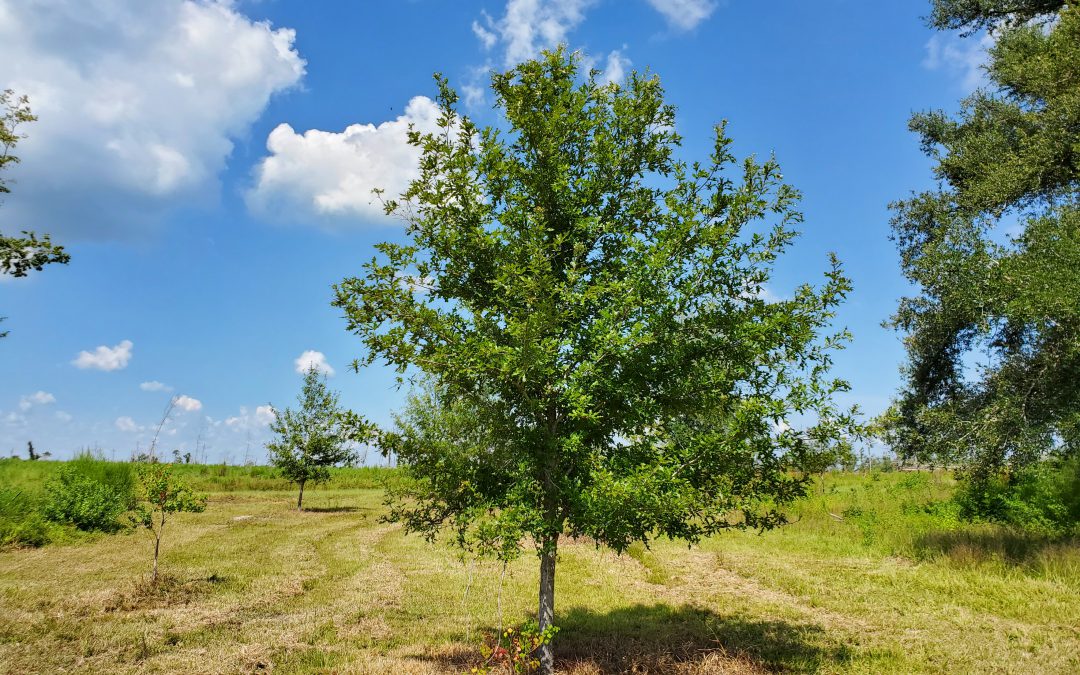
by Daniel J. Leonard | Sep 8, 2020
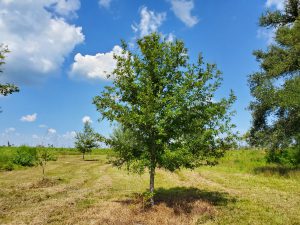
7 year old Overcup Oak (Quercus lyrata) on the edge of a wet weather pond in Calhoun County. Photo courtesy of Daniel Leonard.
Haunting alluvial river bottoms and creek beds across the Deep South, is a highly unusual oak species, Overcup Oak (Quercus lyrata). Unlike nearly any other Oak and most sane people, Overcups occur deep in alluvial swamps and spend most of their lives with their feet wet. Though the species hides out along water’s edge in secluded swamps, it has nevertheless been discovered by the horticultural industry and is becoming one of the favorite species of landscape designers and nurserymen around the South. The reasons for Overcup’s rise are numerous, let’s dive into them.
First, much of the deep South, especially in the Coastal Plain, is dominated by poorly drained flatwoods soils cut through by river systems and dotted with cypress and blackgum ponds. These conditions call for landscape plants that can handle hot, humid air, excess rainfall, and even periodic inundation (standing water). It stands to reason our best tree options for these areas, Sycamore, Bald Cypress, Red Maple, and others, occur naturally in swamps that mimic these conditions. Overcup Oak is one of these hardy species. Overcup goes above and beyond being able to handle a squishy lawn, it is often found inundated for weeks at a time by more than 20’ of water during the spring floods our river systems experience.

The same Overcup Oak thriving under inundation conditions 2 weeks after a heavy rain. Photo courtesy Daniel Leonard.
The species has even developed an interesting adaptation to allow populations to thrive in flooded seasons. Their acorns, preferred food of many waterfowl, are almost totally covered by a buoyant acorn cap, allowing seeds to float downstream until they hit dry land, thus ensuring the species survives and spreads. While it will not survive perpetual inundation like Cypress and Blackgum, if you have a periodically damp area in your lawn where other species struggle, Overcup will shine.
Overcup Oak is also an exceedingly attractive tree. In youth, the species is extremely uniform, with a straight, stout trunk and rounded “lollipop” canopy. This regular habit is maintained into adulthood, where it becomes a stately tree with a distinctly upturned branching habit, lending itself well to mowers and other traffic underneath without having to worry about hitting low-hanging branches. The large, lustrous green leaves are lyre-shaped if you use your imagination (hence the name, Quercus lyrata) and turn a not-unattractive yellowish brown in fall. Overcups especially shines in the winter, however, when the whitish gray, shaggy bark takes center stage. Overcup bark is very reminiscent of White Oak or Shagbark Hickory and is exceedingly pretty relative to other landscape trees that can be successfully grown here.
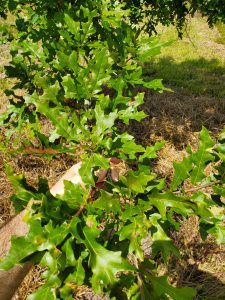
Overcup Oak leaves in August. Note the characteristic “lyre” shape. Photo courtesy Daniel Leonard.
Finally, Overcup Oak is among the easiest to grow landscape trees. We have already discussed its ability to tolerate wet soils and our blazing heat and humidity, but Overcups can also tolerate periodic drought, partial shade, and nearly any soil pH. They are long-lived trees and have no known serious pest or disease problems. They transplant easily from standard nursery containers or dug from a field (if it’s a larger specimen), making establishment in the landscape an easy task. In the establishment phase, defined as the first year or two after transplanting, young, transplanted Overcups require only a weekly rain or irrigation event of around 1” (wetter areas may not require any supplemental irrigation) and bi-annual applications of a general purpose fertilizer, 10-10-10 or similar. After that, they are generally on their own without any help!

Typical shaggy bark on 7 year old Overcup Oak. Photo courtesy Daniel Leonard.
If you’ve been looking for an attractive, low-maintenance tree for a pond bank or just generally wet area in your lawn or property, Overcup Oak might be your answer. For more information on Overcup Oak, other landscape trees and native plants, give your local UF/IFAS County Extension office a call!
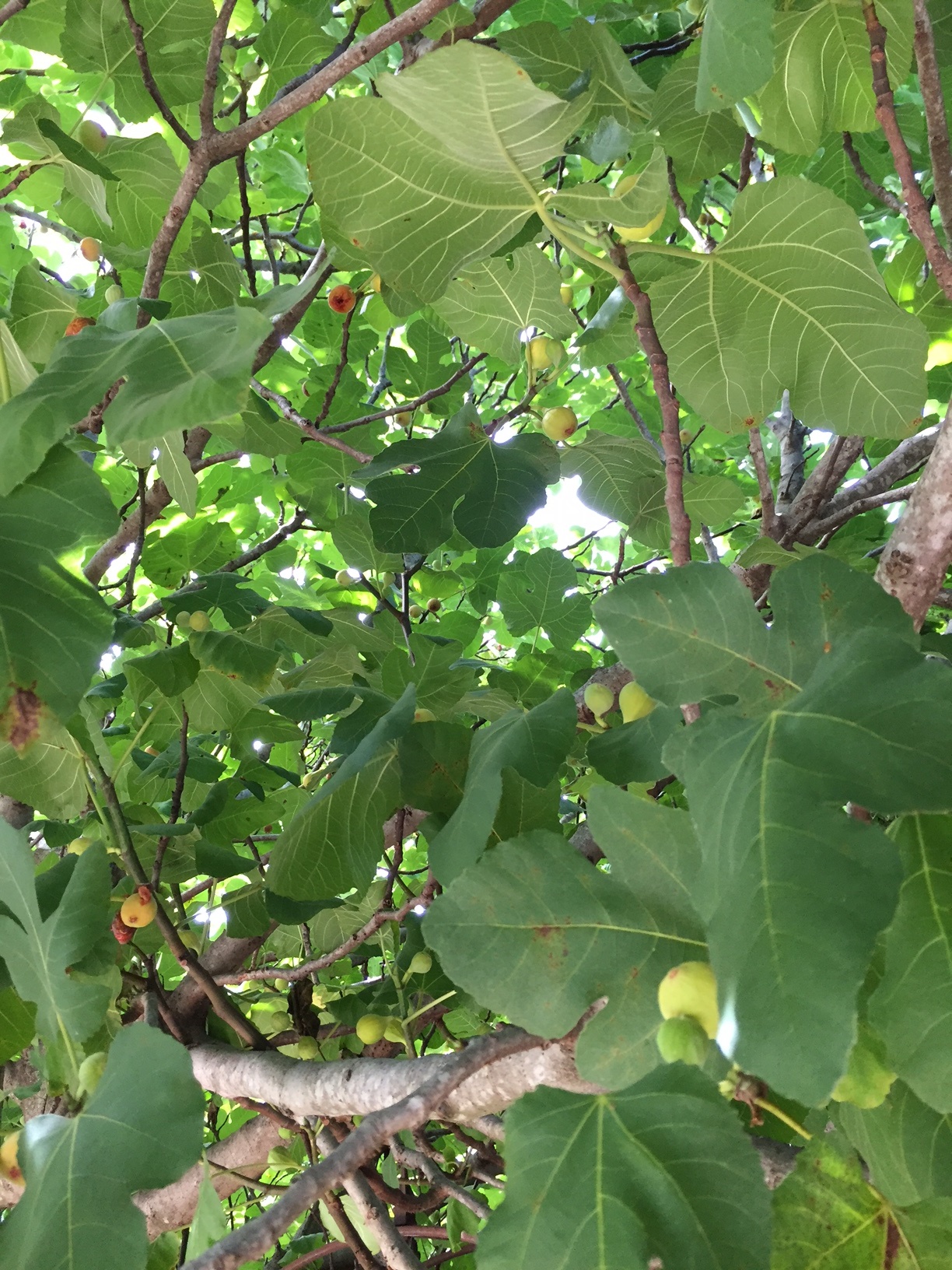
by Carrie Stevenson | Jul 1, 2020
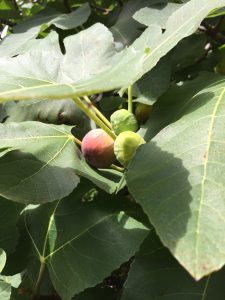
Ripe figs are a deep shade of pink to purple. Larger green figs will ripen in a few days. Photo credit: Carrie Stevenson
Summer is full of simple pleasures—afternoon rainstorms, living in flip flops, and cooling off in a backyard pool. Among these, one of my favorites is walking out my door and picking handfuls of figs right from the tree. Before we planted our tree, my only prior experience with the fruit was a Fig Newton—I’d never eaten an actual fig, much less one picked fresh. Now, they are my favorite fruit.
Native to Asia Minor and the Mediterranean, figs were introduced to Florida in the 1500’s by Spanish explorers. Spanish missionaries introduced these relatives of the mulberry to California a couple hundred years later. Figs are best suited to dry, Mediterranean-type climates, but do quite well in the southeast. Due to our humidity, southern-growing figs are typically fleshier and can split when heavy rains come through. The biggest threats to the health of the trees are insects, disease (also due to our more humid climate) and root-knot nematodes.
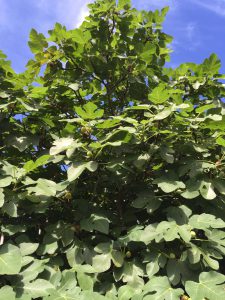
Fig trees can grow quite large and produce hundreds of fruit each year. Photo credit: Carrie Stevenson
Our tree started out just a couple of feet tall, but 15 years ago we replanted it along a fence in our back yard. It grew so large (easily 25 feet tall and equally wide) that it hangs over our driveway, making it handy to grab a few as I head out for a walk or hop in the car to run errands. The tree is in full sun at the bottom of a slope, and seems to be a satisfied recipient of all the runoff from our backyard. This position has resulted in a thick layer of soil and mulch in which it thrives. In the last year, we pruned it down to an arms-reach height so that we could actually get to the figs being produced.
We usually see small green fruit start to appear in early May, becoming fat and ripe by the second half of June. The tree produces steadily through early August, when the leaves turn crispy from the summer heat and there’s no more fruit to bear. The common fig doesn’t require a pollinator, so only one tree is necessary for production. The fiber-rich fig is also full of calcium, potassium, and vitamins A, E, and K. As it turns out, the “fruit” is actually a hollow peduncle (stem) that grows fleshy, forming a structure called a synconium. The synconium is full of unfertilized ovaries, making a fig a container that holds both tiny flowers and fruit in one.

The insides of a fig show the small flowering structures that form the larger fruit. Photo credit: Carrie Stevenson
With the hundreds of figs we’ve picked, my family has made fig preserves, fig ice cream, baked figs and of course eaten them raw. We typically beg friends and neighbors to come help themselves—and bring a ladder—because we can’t keep up with the productivity. The local birds and squirrels are big fans, too. Often you can tell you’re near our tree from around the block, as the aroma of fermenting fruit baking on the driveway is far-reaching.
No matter what you do with them, I encourage planting these trees in your own yard to take full advantage of their sweet, healthy fruit and sprawling shade. As Bill Finch of the Mobile (AL) botanical gardens has written, “fresh…figs are fully enjoyed only by the family that grows them, and the very best figs are inevitably consumed by the person who picks them.”
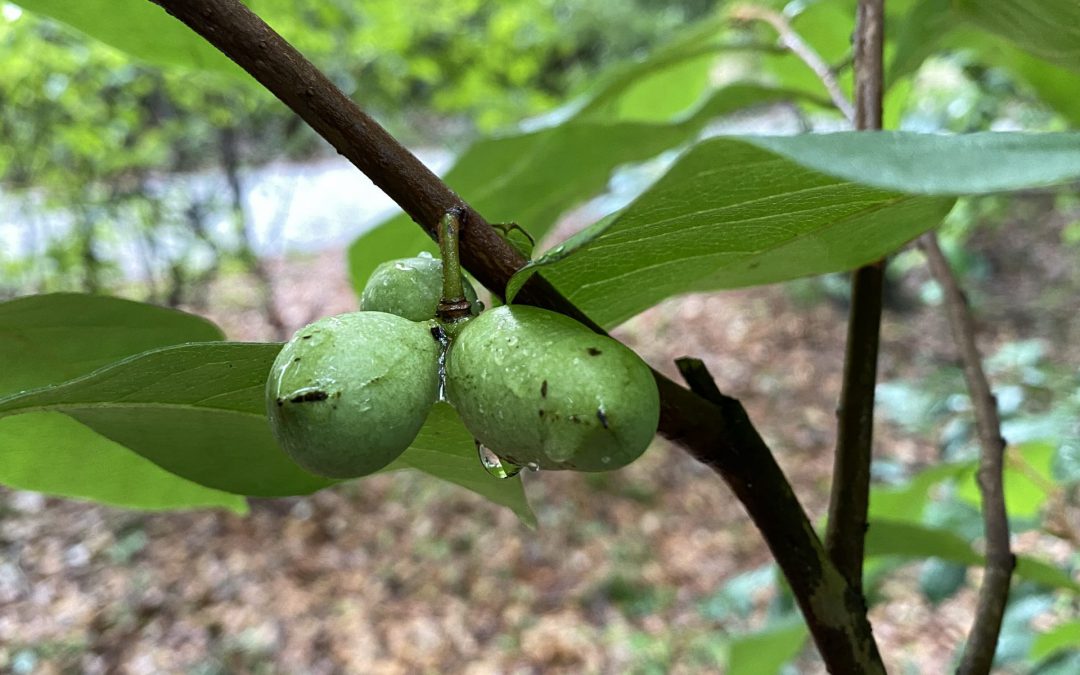
by Matt Lollar | May 20, 2020
The pawpaw (Asimina triloba) is a native edible that is often overlooked and misunderstood. Not only does it produce a delicious fruit that looks like a mango and tastes like a banana, but it is also an aesthetic landscape plant. This fruit is slowly gaining popularity with younger generations and a handful of universities (Kentucky State University and the University of Missouri) are working on cultivar improvements.
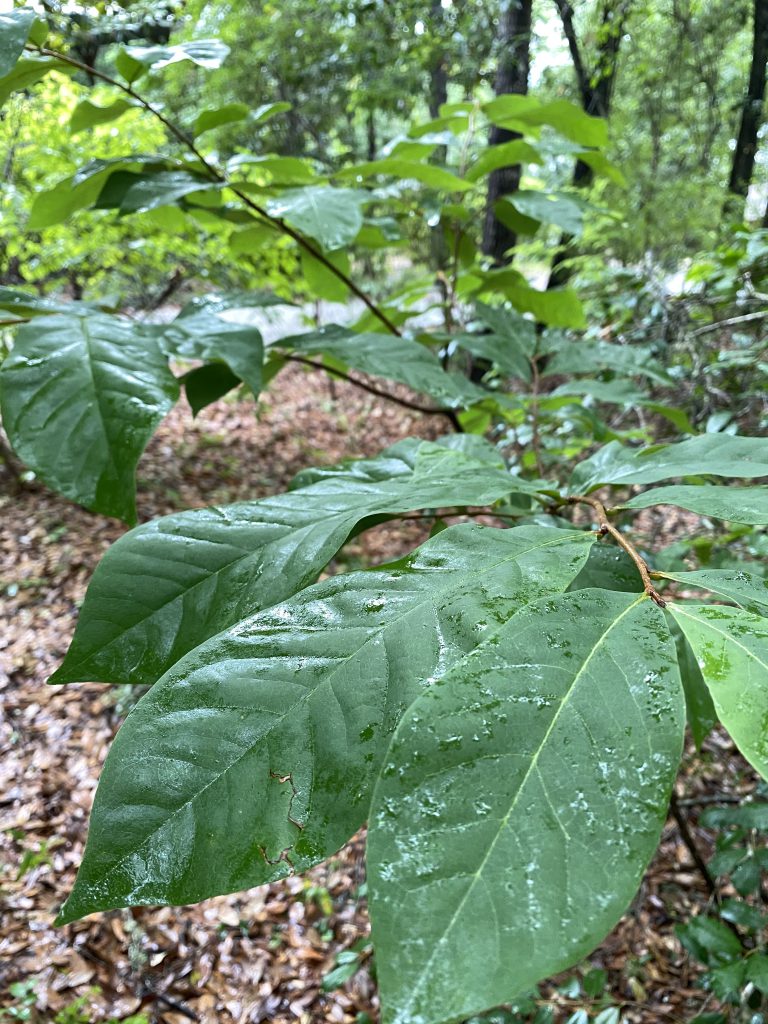
A pawpaw tree growing in the woods. Photo credit: Matt Lollar, University of Florida/IFAS Extension – Santa Rosa County
The pawpaw is native to the eastern United States (USDA Plant Hardiness Zones 5-8), however it’s closest relatives are all tropical such as the custard apple, cherimoya, and soursop. The pawpaw, along with these fruits, are known for their custard-like texture which may be a unpleasant for some consumers. Pawpaws are relatively hardy, have few insect pests, and can still produce fruit in partial shade (although they produce more fruit when grown in full sun).
Pawpaws perform best in moist, well-drained soils with a pH between 5.5 and 7.0. They are found growing wild in full to partial shade, but more fruit are produced when trees are grown in full sun. However, pawpaws need some protection from wind and adequate irrigation in orchard settings. Trees can grow to between 12 feet to 25 feet tall and should be planted at least 15 feet apart. In the Florida Panhandle, flowers bloom in early spring and fruit ripen from August to October depending on variety and weather.
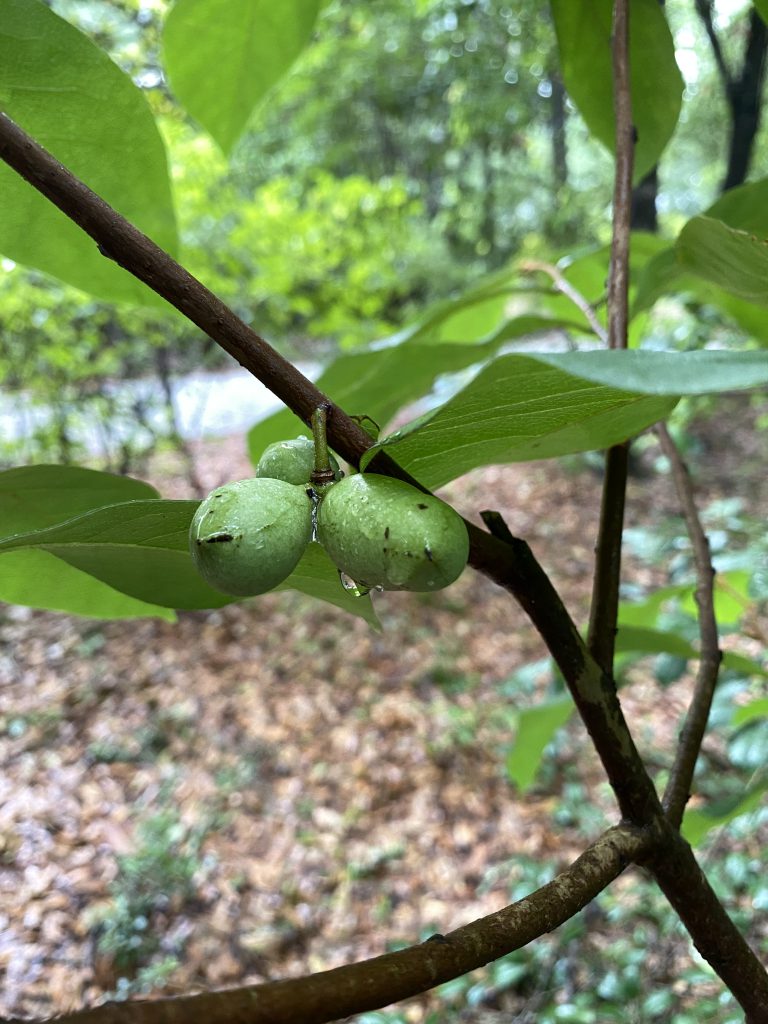
Young pawpaw fruit growing on a small tree. Photo Credit: Matt Lollar, University of Florida/IFAS Extension at Santa Rosa County
A number of improved cultivars of pawpaws have been developed that produce more fruit with more flavor than native seedlings/saplings. The University of Missouri has conducted trials on the following pawpaw cultivars: ‘Sunflower’; ‘PA Golden’; ‘Wells’; ‘NC-1’; ‘Overleese’; ‘Shenandoah’; ‘Susquehanna’; and ’10-35′. Most of these cultivars performed well in southern Missouri, however yields may differ in the Florida Panhandle. The full results of the trial can be found in the “Pawpaw – Unique Native Fruit” publication.
Pawpaws can be propagated by seed or cuttings. Unlike most fruit trees, pawpaws are usually true to seed meaning that saved seed produces a tree with similar characteristics to the parent tree. To save seeds, place fresh seeds in a bag of moist peat moss and refrigerate for 3 to 4 months before planting. To vegetatively propagate, take cuttings (pencil thin in diameter) in the winter and store in a refrigerator until early spring. Cuttings should be chip budded onto seedling rootstock during the spring. Please visit this publication from the University of Nebraska for more information on chip budding.
Pawpaw fruit are ready to harvest when they are slightly soft when gently squeezed. Fruits picked prior to being fully ripe, but after they start to soften, will ripen indoors at room temperature or in a refrigerator. Already-ripe fruit will stay fresh for a few days at room temperature or for a few weeks in the refrigerator. To enjoy pawpaw fruit throughout the year, scoop out the flesh, remove the seeds, and place the flesh in freezer bags and freeze.
Whether you want to add more native plants to your landscape or you are a rare and unusual fruit enthusiast, pawpaw may be the tree for you. They can be utilized as a focal point in the garden and provide delicious fruit for your family. For more information on pawpaw or other fruit trees, please contact your local Extension Office.
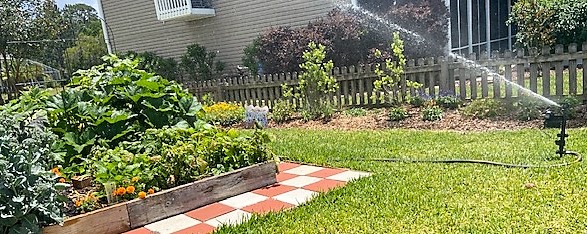
by Mary Salinas | May 14, 2020

White tailed deer. Photo credit: Rebekah D. Wallace University of Georgia bugwood.org.
There doesn’t seem to be any shortage of deer in the panhandle, especially when it comes to them strolling in my yard looking for something tasty to eat. My vegetable garden suffered repeated assaults by hungry deer this past fall and winter. The garlic and cayenne pepper-based products only worked for a few days when freshly applied. I had to try something new this spring.
And my new method has worked. I purchased a motion activated high impact sprinkler that can be set to activate day or night. It has worked like a charm! There are various vendors but I purchased mine through a hardware store online for about $70. I put a splitter on my closest outdoor spigot and have a dedicated hose running to the sprinkler. This allows me to also have a regular hose for watering attached to the spigot. The hose must be turned on all the time. One problem that I am hoping to avoid this summer is that the water in the hose may get too hot in the summer heat and split the hose, so I am looking to maybe trench to keep the hose and the water inside a bit cooler.

Motion activated impact sprinkler protecting the vegetable garden from ravenous deer. Photo credit: Mary Salinas, UF/IFAS Extension.
You can also choose plants that deer do not like to eat such as live oak, dogwood, muhly grass, coneflower and black-eyed Susan. However, keep in mind that when food is scarce deer will forage on plants that they normally would not eat. Southern magnolia is considered quite deer resistant but the one I planted this past winter was mostly defoliated by deer.
The University of Florida has a publication with many other strategies on controlling deer: Coping with Deer Damage in Florida.
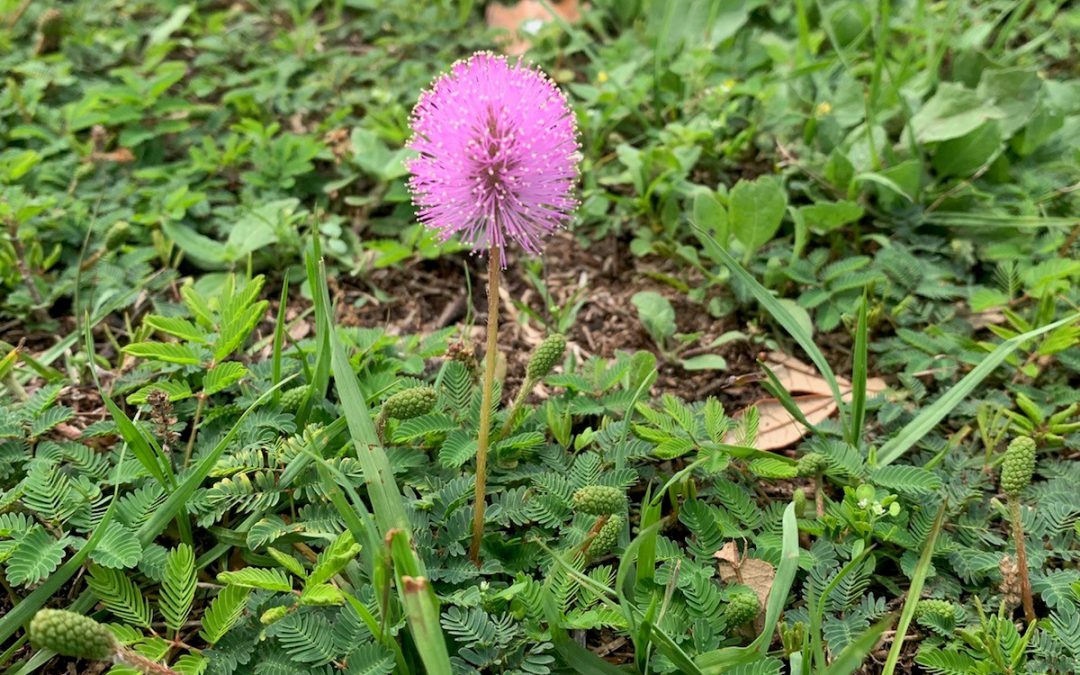
by Ray Bodrey | May 13, 2020
Powderpuff mimosa (Mimosa strigillosa), also called Sunshine Mimosa or Sensitive Plant, is an increasingly popular native plant for home and commercial landscape applications that offers a very show display of puffy pink flowers this time of year!
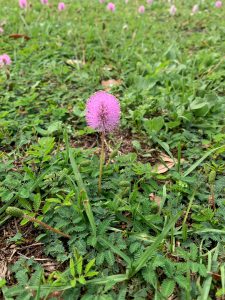
Powderpuff Mimosa, (Mimosa strigillosa). Photo courtesy of Ray Bodrey.
This Florida native, low-growing groundcover grows no more than eight inches in height, and that would be classified as an extremely vigorous stand. Powderpuff Mimosa is technically a perennial legume, meaning it doesn’t need any nitrogen fertilizer from gardeners.
The groundcover is appealing to the eye with its dark green fern-like leaves. Not an evergreen, the plants fall into a semi-dormant to dormant state during the fall and winter seasons. Powderpuff Mimosa is a very resilient groundcover as well, needing little irrigation, spreading quickly, and co-existing well with turfgrass. Just a few pots of this species transplanted should cover up to 300 square feet in a season. Although it spreads quickly, it can easily be pruned or mowed if it moves into unwanted areas.
Powderpuff mimosa is a great plant for erosion control due to its deep roots. These deep roots also allow for good levels of drought tolerance. There are very few insect or disease problems with this plant, other than the occasional caterpillar. It is a very wildlife and pollinator friendly plant, with honeybees, butterflies, deer, and more all finding it appealing. It’s even considered a livestock forage, as cattle find it palatable.
Looking to plant powderpuff mimosa in your landscape? Any area that gets mostly full sun is just fine. This plant is adapted to a wide range of soils, but particularly flourishes in well-drained, sandy loam soils. Be sure to water regularly, especially to ensure successful establishment in your landscape. Find this wonderful little plant at Florida native plant nurseries!
For more information contact the Gulf County Extension Office at 639-3200 or email at rbodrey@ufl.edu.
Supporting information for this article can be found in the UF/IFAS Extension website: https://gardeningsolutions.ifas.ufl.edu/plants/ornamentals/powderpuff-mimosa.html & USDA website: https://plants.usda.gov/plantguide/pdf/pg_mist2.pdf
UF/IFAS Extension is an Equal Opportunity Institution.

by Larry Williams | Apr 23, 2020
One of the things to do while stuck at home due to COVID-19 restrictions, is to look for caterpillars and butterflies in your landscape. I’ve noticed giant swallowtail butterflies (Papilio cresphontes) a little early this year. The giant swallowtail is one of the largest and most beautiful butterflies in our area. Its larval stage is known as the orangedog caterpillar. This unusual name comes from the fact that it feeds on young foliage of citrus trees.
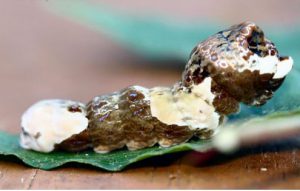
Orangedog caterpillar. Photo credit: Donald Hall, University of Florida
The orangedog caterpillar is mostly brown with some white blotches, resembling bird droppings more than a caterpillar. When disturbed, it may try to scare you off by extruding two orange horns that produce a pungent odor hard to wash off.
I’ve had some minor feeding on citrus trees in my landscape from orangedog caterpillars. But I tolerate them. I’m not growing the citrus to sell. Sure the caterpillars eat a few leaves but my citrus trees have thousands of leaves. New leaves eventually replace the eaten ones. I leave the caterpillars alone. They eat a few leaves, develop into chrysalises and then emerge as beautiful giant swallowtail butterflies. The whole experience is a great life lesson for my two teenagers. And, we get to enjoy beautiful giant swallowtail butterflies flying around in our landscape and still get plenty of fruit from the citrus trees. It is a win, win, win.
In some cases, the caterpillars can cause widespread defoliation of citrus. A few orangedog caterpillars can defoliate small, potted citrus trees. Where you cannot tolerate their feeding habits, remove them from the plant. But consider relocating the caterpillars to another area. In addition to citrus, the orangedog caterpillars will use the herb fennel (Foeniculum vulgare) and rue (Ruta graveolens) as a food source. Some butterfly gardens plant citrus trees to provide food for orangedog caterpillars so that they will have giant swallowtail butterflies. So you could plan ahead and grow some fennel, rue or find a butterfly garden in your area for the purpose of relocating the larvae.
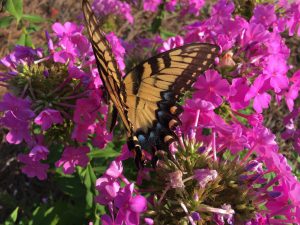
Yellow giant swallowtail butterfly on pink garden phlox flowers. Photo credit: Larry Williams
The adult butterflies feed on nectar from many flowers, including azalea, bougainvillea, Japanese honeysuckle, goldenrod, dame’s rocket, bouncing Bet and swamp milkweed. Some plants in this list might be invasive.
Keep in mind that mature citrus trees can easily withstand the loss of a few leaves. If you find and allow a few orangedog caterpillars to feed on a few leaves of a mature citrus tree in your landscape, you and your neighbors might get to enjoy the spectacular giant swallowtail butterfly.
More information on the giant swallowtail butterfly is available online at http://edis.ifas.ufl.edu/in134.




















